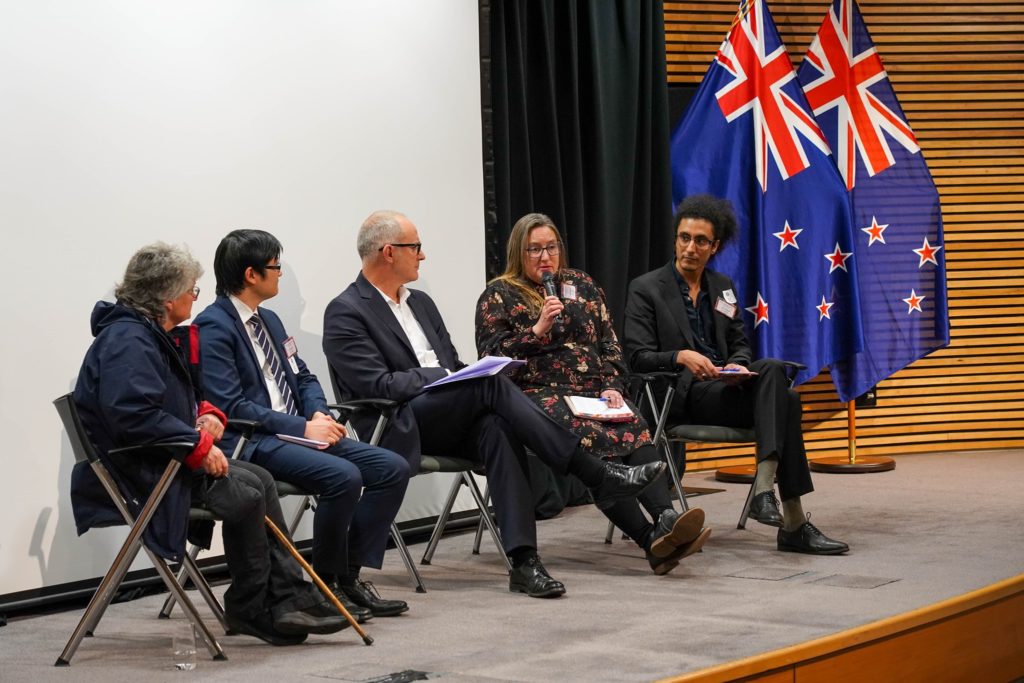
Aotearoa New Zealand’s Minister for Disarmament and Arms Control, Hon. Phil Twyford, hosted a Dialogue on Autonomous Weapons and Human Control at Parliament on 10 August 2021. According to the programme, “inaction on weapons systems that can select and engage targets without human intervention risks a future of warfare and policing outside of human control and responsibility.” The Dialogue considered New Zealand’s potential role in the international effort to ban and regulate autonomous weapons systems and retain meaningful human control over the use of force.
Taking action on killer robots is a key objective of the government’s 2021-2022 Disarmament Strategy, presented by the Minister in June 2021. As part of the strategy, the Ministry for Foreign Affairs and Trade has embarked on a consultation process to seek insights and diverse perspectives on concerns over autonomous weapons and input on the approach the government should take regarding regulation.
The Dialogue saw convergence on the urgent need for greater New Zealand action due to multiple concerns raised by autonomous weapons systems. Divergences that emerged during the discussion centered around ambition, resourcing, and timing of international regulation. There were some differences regarding the content needed for new legal rules such as definitions and scope. But overall the Dialogue and new survey show how public opposition to killer robots is firm and growing. There’s a visceral reaction against allowing machines to kill people. This serves as a firm basis for taking action to create new legal rules to prohibit and regulate autonomous weapons systems.
Speakers
Hon. Phil Twyford, Minister for Disarmament and Arms Control
In his opening statement, the Minister outlined some of the fundamental ethical, legal, proliferation and security raised by removing human control from the use of force. He shared the results from a new survey of 2,000 New Zealanders that found 72 percent of respondents oppose autonomous weapons systems. All demographic groups (based on gender, age, ethnicity, geographic location, income or educational attainment), more New Zealanders oppose killer robots than support them.
The following speakers each gave a 5-minute presentation.
Andrew Chen, Research Fellow, Centre for Informed Futures at the University of Auckland
Andrew’s work considers the social and ethical implications of the technological tools and systems in development. He said that when it comes to the decision to end a person’s life, he said we cannot allow some lines of code take that humanity away from us. Andrew recommended development of a national strategy that leads to international engagement to achieve a legally-binding instrument on autonomous weapons systems. @andrewtychen @informedfutures
Edwina Hughes, Aotearoa New Zealand Campaign to Stop Killer Robots
Edwina outlined the Campaign’s objectives of national legislation to prohibit autonomous weapons systems and international leadership by New Zealand to achieve a new international ban treaty. The Aotearoa New Zealand Campaign to Stop Killer Robots and the yDISARM Youth Disarmament Project are running an online survey to contribute to the development of new government policy on autonomous weapons. @PeaceMovementA @KillerRobotsNZ
Sakhr Munassar, Youth Activator, New Zealand Red Cross
Sakhr referred to legal questions over autonomous weapons systems and said that substituting human decisions over life and death to machines raises fundamental ethical concerns for humanity. He reiterated the 2021 decision by the International Committee of the Red Cross to work for new international legal standards to prohibit and regulate autonomous weapons systems. @Sakhr_M @NZRedCross
Mary Wareham, Arms Advocacy Director, Human Rights Watch
Mary said that allowing the use of autonomous weapons systems threatens fundamental human rights and human dignity. As global coordinator of the Campaign to Stop Killer Robots until returning home to New Zealand in March 2021, Mary said she’s more than willing to talk about the concerns over removing human control from the use of force, but what is done about it matters more at this point. She regards a new international treaty banning autonomous weapons systems as an ethical imperative, legal necessity and moral obligation. @marywareham @hrw @bankillerrobots
Video Messages
Links to each video message received by the New Zealand Dialogue on Autonomous Weapons and Human Control are provided below and a full transcript is also available. Highlights from the messages are available in this edited 8.40-minute video.
Jody Williams, Nobel Peace Laureate
Jody highlighted New Zealand’s legacy of protest over nuclear weapons and its subsequent work to ban landmines and cluster bombs as pivotal in helping to address humanitarian challenges. She described current diplomatic talks on killer robots as on “a road to nowhere” and urged New Zealand to help come up with “a new plan, a new process, and a new venue where serious talks on these weapons can actually take place.” Jody supported the Minister’s invitation to allies in this cause, to come together and negotiate a new international treaty to stop killer robots. @JodyWilliams97 @NobelWomen
Mitzi Austero, Non-Violence International Southeast Asia
Mitzi thanked New Zealand’s Minister and officials for their efforts to bring energy to humanitarian disarmament, to develop a national policy and encouraged the government to help prohibit weapons systems that can select, target, and decide to use force without human intervention. Her colleague, youth representative Alliah Ampatuan, said that “deciding on the future of autonomous weapons systems is like deciding what problems of mine and the children of today will face in our future, when it is our time to lead” @mitziaustero @NonviolenceAsia
Dr. Thompson Chengeta, International Committee for Robot Arms Control
Thompson expressed is expectation that African states would be willing to work with the government of New Zealand to start the process of negotiating, or championing at least, a new legally binding instrument on killer robots. New Zealand and other likeminded states to start seriously thinking about options of how to negotiate a legally binding instrument outside the framework of the Convention on Conventional Weapons (CCW). @DrThompsonLaw @icracnet
Raza Shah Khan, Sustainable Peace & Development Organization
Raza welcomed the momentum and attention that the Minister is bringing to humanitarian disarmament. He described a ban on autonomous weapons systems as a priority for Pakistan and the Non-Aligned Movement. Raza attended the Wellington Conference on Cluster Munitions in February 2008 and urged New Zealand to again work with like-minded states again to conclude a new international treaty prohibiting killer robots. @razashahkhan1 @SPADOPakistan
Wanda Munoz Human Security Network in Latin America and the Caribbean (SEHLAC)
Wanda said that New Zealand’s process to develop national policy on killer robots is encouraging for civil society, particularly those in the global south which will probably be the first, and worst affected countries by autonomous weapons systems. She recommended New Zealand seek a Convention on Conventional Weapons mandate in December to negotiate a new protocol on killer robots and also recommended the government begin talking now with likeminded states about how to launch a stand-alone process to adopt a new treaty to ensure that that machines never take a decision over life and death. @_wandamunoz @SEHLACorg
John Rodsted, Safe Ground Australia
John said it is “a step too far” to create a weapons system that, once launched, seeks out targets, decides, and executes humans with its own algorithmic decision-making process without any human meaningfully in that loop. He warned of massive humanitarian consequences. John said that Australia and New Zealand are well-placed to assume leadership roles to fold the idea of lethal autonomous weapons systems into a bad one that’s relegated to the back pages of future history books. @SafeGroundInc @ban_kr_aus
Professor Noel Sharkey, International Committee for Robot Arms Control
An eminent Professor of Artificial Intelligence and Robotics, Noel said he has been warning of the dangers of autonomous weapons systems since 2006. He said the past eight years of diplomatic talks have resulted in strong consensus about the importance of some form of human control over the use of force. Noel said that New Zealand’s help on regulation “would make all the difference” especially with countries sitting on the fence when it comes to supporting a new international treaty. @NoelSharkey @StopTheRobotWar @icracnet
Major General Mike Smith (Ret’d)
Mike is an Officer in the Order of Australia who had a distinguished 34-year career in the Australian Army, which started as an infantry officer and culminated with commanding all levels from Platoon to Brigade Commander. Speaking in his personal capacity, he warned that lethal autonomous weapons systems have the ability to remove humans from the decision loop, thereby allowing machines, or robots, to make decisions of life-and-death. Mike said that this scary, but very real proposition, raises the urgent need for arms control to a new and unprecedented level.
For more information, see:
Programme and Speech by Hon. Phil Twyford, Dialogue on Autonomous Weapons and Human Control, 10 August 2021.
New Zealand’s 2021-2022 Disarmament Strategy (narrative & infographic). Colmar Brunton, New Zealand Public Survey on Autonomous Weapons Systems, August 2021.
Sam Sachdeva, “Pace picks up in the war against ‘killer robots,’” Newsroom, 10 August 2021.
Thomas Manch, “New Zealanders concerned about ‘killer robots’ as Government pushes against new arms race,” Stuff NZ, 12 August 2021.
Jeremy Moses, Geoffrey Ford and Sian Troath, “NZ could take a global lead in controlling the development of ‘killer robots’ — so why isn’t it?” Radio New Zealand, 19 August 2021.

Leave a Reply